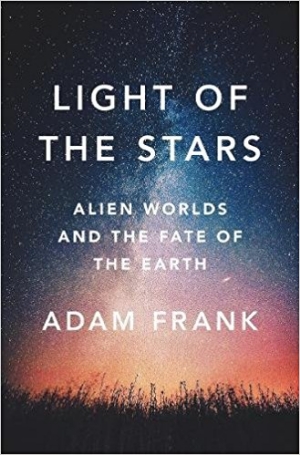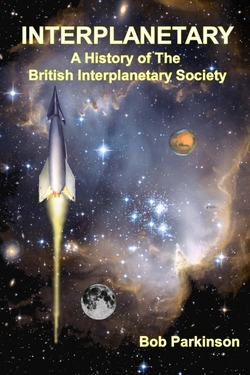Centauri Dreams
Imagining and Planning Interstellar Exploration
Plate Tectonics: Necessary for Habitability?
Just how important is plate tectonics for the development of complex life? We’ve learned that its continual churn, with material pushing up from ocean rifts and being subducted as it meets continental shelves, can moderate the Earth’s climate. Increasing temperatures are tamped down through the capture of excess carbon dioxide in rocks, which reduces potential greenhouse conditions. Lowering temperatures will produce the reverse effect. The result is a mechanism for maintaining stable temperatures that some have seen as necessary for life.
“Volcanism releases gases into the atmosphere, and then through weathering, carbon dioxide is pulled from the atmosphere and sequestered into surface rocks and sediment,” said Bradford Foley, assistant professor of geosciences at Penn State University. “Balancing those two processes keeps carbon dioxide at a certain level in the atmosphere, which is really important for whether the climate stays temperate and suitable for life.”
And indeed, most of the volcanoes on our planet are found on the border between tectonic plates. Here, too, plates being driven deeper into the subsurface through subduction push carbon deep into the mantle as the cycle continues. But we also know that the Earth is the only planet in the Solar System on which plate tectonics has been confirmed. Planets without such plates are known as stagnant lid planets, coping with a crust made up of a single spherical plate floating on the mantle. Should we rule out such planets as candidates for life?
Penn State’s Foley, cited above, has been working with colleague Andrew Smye on computer models that probe the idea. The scientists wanted to learn whether climate regulation through chemical weathering could be sustained on a stagnant lid planet,a place where there is no subduction and the recycling of surface material back into the mantle would be limited. On such a world, the development of continents and their productive collisions would not occur, although as the paper points out, volcanism can still release some mantle CO2 to the atmosphere, allowing for at least some degree of surface recycling through lava flows.
Foley and Smye’s simulations are restricted to planets that are Earth-like in size and composition, given the steep uncertainties in our knowledge of volcanism and outgassing on planets with different mantle compositions. Their work models conditions on Earth-like stagnant lid planets in terms of weathering, CO2 outgassing, and changing heat retention in the crust. The question is whether chemical weathering can balance the CO2 being released on such worlds, and whether there is enough outgassing to keep the surface from freezing over. And we learn that ruling out life on stagnant lid planets would be premature.
For given volcanic outgassing in the right amounts and a suitable planetary composition, clement conditions on the surface can be produced and sustained, all without plate tectonics:
Models of the thermal, magmatic, and degassing history of rocky planets with Earth-like size and composition demonstrate that a carbon cycle capable of regulating atmospheric CO2 content, and stabilizing climate to temperate surface temperatures, can potentially operate on geological timescales on planets in the stagnant lid regime. Plate tectonics may not be required for habitability, at least in regard to sustaining a stable, temperate climate on a planet.
In fact, the authors find the potential for moderate climates that can last up to 5 billion years, after which volcanism and CO2 outgassing would cease and the climate would cool below the freezing point of water, inducing glaciation on the surface. Everything depends upon the planet’s supply of CO2, and that takes us back to its formation:
At CO2 budgets lower than ?1020 mol, a planet’s climate is estimated to be in a snowball state for its entire history, while above ?1022 mol weathering would become supply-limited. With supply-limited weathering, CO2 outgassing overwhelms CO2 drawdown, such that an inhospitably hot, CO2-rich atmosphere forms. Thus, the amount of carbon accreted to a planet during formation is critical for whether it can sustain habitable surface conditions in a stagnant lid regime.
The amount of carbon most conducive for habitable conditions turns out to be somewhere between Earth’s total amount of carbon to about 10 times less carbon than is found in today’s atmosphere, mantle and crust combined. Below that, the planet does not stay warm enough for liquid water to survive on the surface.

Image: This is Figure 5 from the paper. Caption: Time when the total degassing flux, Fd?+?Fmeta, falls below Earth’s present-day degassing flux (A) and below 10% of Earth’s present-day degassing flux (B). Labeled contours give this time in billions of years. To the right of the dashed line (shaded region), weathering will be supply-limited assuming an eruption efficiency of 0.1. Credit: Bradford Foley / Andrew Smye.
Thus carbon dioxide can still escape from rocks in a degassing process that takes it to the surface, a process that depends on the types and quantities of heat-producing elements found in the planet. The planet’s initial composition tells the tale. The work indicates that high internal heating rates favor long-term habitability, and points to young planets as more likely to experience sufficient rates of CO2 outgassing. In the hunt for biosignatures, the authors argue for planets orbiting stars with high thorium or uranium abundance, because these are the most likely to contain the necessary constituents to produce sufficient internal heat.
The paper is Foley, B. J. and A. J. Smye (2018), “Carbon cycling and habitability of Earth-size stagnant lid planets,” Astrobiology, Vol. 18, Issue 7 (2018), 873-896. Full text.

Toward An Archaeology of Exo-Civilizations
Light of the Stars: Alien Worlds and the Fate of the Earth, by Adam Frank. W.W. Norton & Co. (2018), 272 pp.
Although he has published several previous books and is well represented in the technical literature, Adam Frank (University of Rochester) found himself suddenly thrust onto the public stage with an op-ed he wrote in the New York Times in 2016. Chosen by the paper’s editors, the title “Yes, There Have Been Aliens” injected a certainty Frank didn’t intend, but it brought up an intriguing point: We may not know whether other technological civilizations exist now, but the odds are exceedingly good that at some point, somewhere, they once did.
Frank and colleague Woody Sullivan had written the original idea up for Astrobiology, the result of their pondering how exoplanet data now streaming in could be used to refine the original Drake equation, which sets up the factors thought to determine the prevalence of technological societies in the universe. In his new book Light of the Stars, Frank explains by way of background that the duo realized they needed to change Drake’s focus by removing the question of the average lifetime of such a culture.
For the time being, then, the L factor that Drake used to cover the average lifetime of a technological civilization would be ignored (though it permeates the book in ways we’ll soon see). For now, let’s look at what our exoplanet data are telling us. For thanks to missions like Kepler and the effort going into other planet hunting methods from radial velocity to gravitational microlensing, we’re learning how to answer the astronomical terms in the Drake equation.
Ponder: We have a good read on the number of stars with planets, something Drake couldn’t have known in his early formulation (the value is now thought to be about 1, meaning just about every star we can see will have at least one planet). We can also begin to make estimates of the number of habitable zone planets around each star, another factor in the Drake equation, and Frank goes with the figure of one in five stars hosting a planet with a chance for life as we know it. That means planets with liquid water on their surface, the classic habitable zone definition.
Frank and Sullivan chose to re-write the Drake equation with the new values incorporated but without reference to L. They pursued the probability that humans might be the only civilization the universe has yet produced. Their answer: 10-22, which means one in ten billion trillion. The number identified what the author calls ‘the pessimism line.’ From the book:

To understand how to think about the pessimism line, imagine you were handed a very big bag of Goldilocks-zone planets. Our results say the only way human beings are unique as a civilization-building species would be if you pulled out ten billion trillion planets and not one of them had a civilization. That’s because Kepler has shown us that there must be ten billion trillion Goldilocks-zone planets in the universe. So the pessimism line is really telling us how bad the probability of a civilization forming would have to be in order for ours to be [the] only one that has ever existed.
Image: Astrophysicist and author Adam Frank. Credit: University of Rochester.
So while we can’t know how many civilizations exist right now, which was the Drake question (the relevance to SETI is obvious), we can get a sense for the odds that somewhere, somewhen, civilization has formed. As the author points out, your chance of being killed by lightning in any given year is about one in ten million. And that would be a thousand trillion times more likely than our species being the only civilization in the history of the cosmos.
You can see why this caught the attention of journalists and the public at large. We’ve looked at Frank’s work quite a few times on Centauri Dreams, as a look through the archives will show (the best place to start is probably Perspectives on Cosmic Archaeology). A criticism Frank addresses straightforwardly in the book is the obvious one: We have no information on the odds for abiogenesis itself, without which we can’t rule out the prospect that we are alone in the universe. Likewise we have no data on how likely intelligence is to develop once life has begun. We are dealing here solely in terms of probabilities, and probability is not proof.
Even so, these probabilities really are striking. The passages in Light of the Stars covering this work are among the most compelling in the book. Frank compares the one in ten billion trillion number to the pessimistic predictions of others who have addressed the probability of intelligent life arising. Ernst Mayr, for example, ruled it out because while he believed life could be common, only one of approximately 50 billion species that have existed on Earth had produced a civilization. But even given Mayr’s strictures, the sheer number of stars and planets implies at least 10 million high-tech civilizations have at some point developed somewhere.
The universe has had plenty of time and opportunity, in other words, to produce civilizations. Combine that with the fact that we have begun to understand, through our missions to other planets in our own Solar System, something about how planets grow and change over time. Thus the challenges we face in our own anthropocene era as we adapt our civilization to the planet around us and inescapably cause change to it — as all life has done — have likely been faced by many cultures, who have either found a way to make civilization an enduring process or have succumbed to planetary catastrophe driven by their growing demands for energy.
Life and Planetary Evolution
Life itself is a game-changer for planetary environments, operating on our world long before humans emerged. The single-celled organisms of the Archaean eon so early in the history of our planet would gradually have to cope with photosynthetic organisms. Eventually cyanobacteria began producing huge amounts of oxygen in what is known as the Great Oxidation Event. The sharp increase in atmospheric oxygen proved poisonous to pre-existing life but also allowed the evolution of creatures with far more interesting metabolisms.
So, what does the GOE, with all its power and reach, teach us about the Anthropocene? It demonstrates that life is not an afterthought in the planet’s evolution. It didn’t just show up on Earth and go along for the ride. The GOE makes it clear that, at an earlier point in Earth’s history, life fully and completely changed the course of planetary evolution. It shows us that what we are doing today in driving the Anthropocene is neither novel nor unprecedented. But it also tells us that changing the planet may not work out well for the specific forms of life that caused the change. The oxygen-producing (but non-oxygen-breathing) bacteria were forced off the Earth’s surface by their own activity in the GOE.
What Frank would like to arrive at is a ‘theoretical archaeology of exo-civilizations,’ a goal that seems philosophical at best, but one which can be interestingly modeled through computer simulations. The Second Law of Thermodynamics gives us insights into the feedbacks that energy use and the production of waste have on planetary systems. Frank would like to model young civilizations using combustion, wind and tidal power, geothermal methods, solar energy and nuclear in a huge variety of planetary environments to calculate the planetary impact.
A planet that lives close to the inner edge of its habitable zone might be so highly sensitive to runaway greenhouse warming that its civilization barely has time to progress before it faces its own version of the Anthropocene and collapses. Another world, farther out from its star, may be less sensitive to planetary change but have a civilization that refuses to recognize the change until the die-off has already begun. A different species on a different world could manage to build its project of civilization using only lower-impact forms of energy and make a gentle soft landing to a sustainable state that lasts thousands of millennia.
Now you can see how we circle back around to Drake’s final factor, L. It was useful for SETI because it helped to define the odds of discovering a currently existing civilization through our various methods of detection. But if we can develop simulated histories for hundreds of thousands of exoplanets in order to tweak the parameters of their civilizational responses to the changes they create on their home worlds, we can calculate an average civilization lifetime.
Frank sees this discussion as leading beyond this early research to increasingly realistic models fed by exoplanet studies, models that can be run for as many iterations as needed to simulate the possible trajectories of a vast number of worlds. These models can give us a sense for likelihoods that can have relevance to our own civilization’s future as we grapple with what must be universal issues of energy use and the inexorable scaffolding of thermodynamics. Don’t spend much time looking for a way around the Second Law of Thermodynamics, Frank advises. Most likely it’s simply ‘baked into the structure of the universe.’
Frank is thus calling for the development of a roadmap for civilizations to rise to Nikolai Kardashev’s Type 1 classification, meaning a society capable of capturing all the light energy reaching its planet from the host star, and perhaps, having survived this journey, able to rise even higher up the Kardashev scale. That scale, first presented at a famous meeting in Byurakan Observatory in Armenia, is another piece of the history of astrobiology that Frank examines in Light of the Stars, presenting a useful backgrounder for anyone hoping to discover how our views of the interactions between technology and our planet have been understood over time.
Drawing on the findings of the space program and exoplanetary research, Frank presents the Earth as one more example of a planet that needs to be understood as a tightly coupled system. Our civilization presents our world with only the latest of its challenges. The book is an eloquent call for harnessing our mathematical tools coupled with an exoplanet data influx to gain insight into our own transition to a stable pattern of growth. That pattern, if we assume ever increasing energy use, could well take a culture like ours off planet and into its local stellar system.

On to Ultima Thule
I am now back on the job, and somewhere beyond Pluto seems a good place to go. Somehow it seems safer out there. While vacationing here on Earth, I was bitten by a brown recluse spider, spent two weeks with a swollen and painful foot, and came down with the most intense flu-like symptoms I’ve ever experienced. The final indignity: I received my monthly report on Centauri Dreams reader statistics. Since I had done no posting for a large portion of this report, I was curious to find out how much traffic had slowed in my absence. It turned out that traffic increased right after I stopped posting and stayed robust the entire time.
I am trying to figure out what this means…
But back to New Horizons, putting my tumultuous vacation experience behind me. Anyone who remembers how hard it was to find a suitable Kuiper Belt Object to serve as New Horizons’ next target will understand how challenging it would be to observe MU69 from the ground. The distant object, perhaps a binary, must be made to yield as many of its secrets as possible as our spacecraft continues the journey that will culminate in a New Year’s Day 2019 flyby. The effort proceeds by the observation of stellar occultations by hardworking mobile teams.
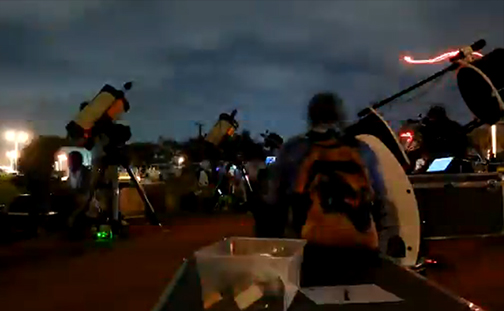
Image: Practicing for the August 2018 Senegal MU69 occultation. Credit: NASA/Johns Hopkins University Applied Physics Laboratory.
What good news, then, to hear from the New Horizons scientists that the latest effort to catch MU69 (recently dubbed ‘Ultima Thule’) passing in front of a much more distant star has been successful. An earlier effort took scientists to Argentina and South Africa in June of last year, while in July of 2017 the NASA Stratospheric Observatory for Infrared Astronomy (SOFIA) probed the area around the object for debris that could pose a collision hazard to the spacecraft. The Hubble instrument also examined the region that same month.
But it’s the ground-based effort that fascinates me. Because when I think of eclipses, I think about large bodies like the Moon passing in front of the Sun, or Earth’s shadow darkening the Moon. Yet the New Horizons effort is likewise the attempt to track an eclipse, one so demanding that it takes pinpoint geographical precision and sheer luck to pull in the data. The strips of shadow cast by MU69 were no more than 30 kilometers wide, with the teams’ telescopes placed at multiple points to catch the moment when the KBO passed in front of the star. Almost 50 researchers made the trip to Senegal and Colombia for the event.
The earlier occultations yielded measurements indicating that MU69 is an ‘extreme prolate spheroid,’ meaning an object shaped something like an American football. A close binary or even a ‘contact’ binary can’t be ruled out, with two objects actually touching each other.
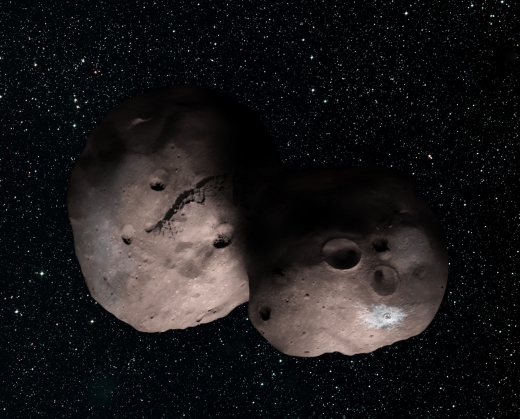
Image: This is one artist’s concept of Kuiper Belt object 2014 MU69, the next flyby target for NASA’s New Horizons mission. This binary concept is based on telescope observations made at Patagonia, Argentina, on July 17, 2017, when MU69 passed in front of a star. New Horizons scientists theorize that it could be a single body with a large chunk taken out of it, or two bodies that are close together or even touching. Credit: NASA/Johns Hopkins University Applied Physics Laboratory/Southwest Research Institute/Alex Parker.
We now turn toward weeks of analysis of the data gathered in Senegal and Colombia on August 3-4. Weather was an issue in the new work just as it was at the team’s multiple sites in Patagonia in 2017.
“Gathering occultation data is an incredibly difficult task,” said New Horizons occultation event leader Marc Buie of the Southwest Research Institute, Boulder, Colorado, who also discovered Ultima Thule about a year before New Horizons flew past Pluto in July 2015. “We are literally at the limit of what we can detect with Hubble and the amount of computer processing needed to resolve the data is staggering.”
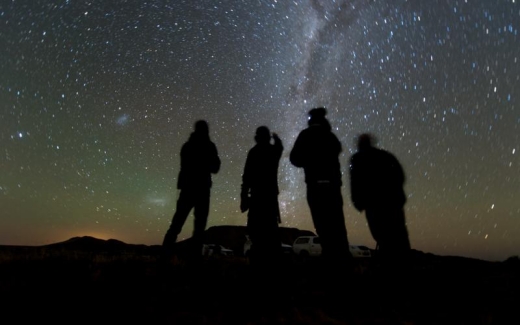
Image: A photo from the previous occultations. Four members of the observation team scan the sky while waiting for the start of the 2014 MU69 occultation, early on the morning of June 3, 2017. The target field was in the Milky Way, seen here from their observation site in the Karoo desert near Vosburg, South Africa. They used portable telescopes in an attempt to observe MU69, a small Kuiper Belt object (now nicknamed Ultima Thule) and the next flyby target the New Horizons spacecraft, pass in front of a star. New Horizons team members made similar observations of Ultima this week in Senegal. Credit: NASA/Johns Hopkins Applied Physics Laboratory/Southwest Research Institute/Southwest Research Institute/Henry Throop.
The spacecraft itself continues to receive commands from Earth in preparation for the Ultima Thule flyby, including memory updates, as subsystem and science instruments are checked out. In September, New Horizons will begin to make observations of the target, which will once again help to refine the spacecraft’s course for the flyby. The distance between spacecraft and KBO for the event is now planned to be 3,500 kilometers. When it occurs, at 6.5 billion kilometers from Earth, tiny Ultima Thule will become the most distant object ever explored.

Revising the Classical ‘Habitable Zone’
With my time-out period over (more about this next week), I want to get back into gear with the help of Ramses Ramirez, a specialist on planetary habitability whose work has now taken him to Japan. Born and raised in New York City, Ramses tells me he is much at home in his new position as a research scientist at the Earth-Life Science Institute (ELSI) in Tokyo, where opportunities for scientific collaboration abound and the chance to learn a new language beckons. We’ve looked at Ramses’ papers a number of times in these pages, and I was delighted when he offered this description of his work to our readership. A student of James Kasting, he received his Ph.D. from Penn State in 2014 and went on to postdoc work with Lisa Kaltenegger at Cornell’s Carl Sagan Institute. A fascination with astrobiology and the issues involved in defining habitable zones continues to be a primary focus. Ramses’ new paper ponders whether we are best served by looking for life similar to Earth’s because this is what we know, or whether there is a broader strategy, one that probes all the assumptions in our ideas of the classical habitable zone.
By Ramses Ramirez

I am glad to have the opportunity to formally introduce myself and give a summary of the recent work on planetary habitability and the habitable zone. I define the habitable zone (HZ) as the circular region around a star(s) where standing bodies of liquid water could exist on the surface of a rocky planet [1]. The inclusion of the phrase “standing bodies of water” excludes dry worlds that may exhibit small outpourings of seasonal surface water (e.g. possibly Mars). Defined this way, the HZ is properly focused for detecting worlds that have large surface bodies of water (e.g. seas, big lakes, oceans) that are in direct contact with the atmosphere. If life is present on such a world, potential atmospheric biosignatures could be detected with current technology. However, in the absence of such large water bodies, life would not be detectable even if it were present. Likewise, although life may be possible within the seas of a Europa or Enceladus exoplanetary analogue, the global ice layer covering their oceans would prevent the detection of such subsurface life. Such observational issues keep the HZ within an orbital region that is placed somewhat closer to the star.
When I first started my Ph.D. in 2010 under my mentor Professor James F. Kasting, I did not know the exact topic that I would be working on at first, but with my interest in the search for extraterrestrial life, I knew that I wanted to work on planetary habitability. Fortunately, I got involved as one of the two lead authors on the 2013 HZ paper [2], where we updated the seminal Kasting et al. [3] HZ limits [2,3]. Although I was fascinated by the HZ concept as a navigational tool to find potentially habitable planets, my investigations soon led me to realize that the HZ definition described in these earlier works, what I dub the “classical HZ”, would be insufficient for capturing the diversity of such planets. From that point on, it became my personal mission to turn the HZ into an even more capable navigational tool.
The classical HZ assumes that CO2 and H2O are the key greenhouse gases on potentially habitable planets, following the carbonate-silicate cycle on the Earth, which is thought to regulate CO2 between the atmosphere, surface, and the interior (e.g. [3]). Given that the concept of a universal carbonate-silicate cycle on habitable exoplanets is itself far from proven (e.g., [4]), I always thought that this assumption was needlessly restrictive and geocentric. After all, HZ planets with atmospheres consisting of different gas mixtures can also support standing bodies of liquid water and potentially be habitable. Reduced greenhouse gases, like H2 and CH4, have been considered as major atmospheric constituents on both early Earth and early Mars (e.g., [5,6]). It has even been suggested that planets with primordial hydrogen envelopes may be habitable in some circumstances [7]. If hypothetical planets consisting of dense 10-bar CO2 atmospheres near the outer edge of the classical HZ are potentially habitable (e.g. [2][3]), then why not worlds composed of these other atmospheric constituents (Figure 1)?

Figure 1: The classical HZ extended to A-stars (blue) with CO2-CH4 (green) and CO2-H2 (red) outer edge extensions for stars of stellar effective temperatures between 2,600 and 10,000 K (reproduced from Ramirez [1]).
Moreover, the classical HZ really targets potentially habitable planets orbiting main-sequence stars. However, this approach ignores the importance of the temporal evolution of the HZ, particularly a star’s pre-main-sequence phase. It is during this early stage that many M-stars are bright and luminous enough to completely desiccate any planets that are now thought to be located within the main-sequence HZ (e.g. [8][9][10]), like Proxima Centauri-b and many of the TRAPPIST-1 planets, unless such worlds are able to accrete enough water to offset losses (e.g., [11][12]) (Figure 2).
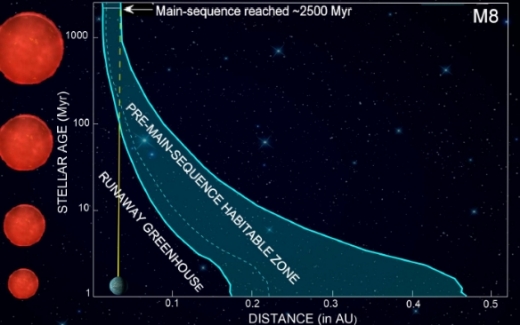
Figure 2: The pre-main-sequence HZ for a late (M8) star. A planet that forms at ~0.03 AU undergoes a runaway greenhouse state for ~100 Myr before finally entering the HZ, settling near the outer edge after ~1 billion years (reproduced from Ramirez [1]).
In my view, we are currently ill-equipped to infer the atmospheric conditions that are most suitable for extraterrestrial life. All we know is that life did somehow arise on this planet. It is therefore pretentious to take our one poorly-understood example and assume that alien life must follow a similar trajectory. Some might argue that we should focus on finding life similar to Earth’s because it is familiar and would be simpler to find. However, this argument from the principle of mediocrity is not convincing to me because we have no idea how common or rare our particular brand of life is until we are able to find a second instance of life’s occurrence elsewhere.
It is then illogical to rely on any one iteration of the HZ to find potentially habitable planets. Our inadequate understanding of biology, the origin of life, and planetary processes require that all of these working hypotheses, including the assumptions used in the classical HZ, be tested by observations. Ideas that are later found to be unsupported by nature can then be rejected whereas those that are confirmed should be refined. Only then will we begin to truly understand life’s possibilities and make more informed – and possibly more restrictive – design decisions for subsequent missions. But only proper observations (and possibly better theoretical constraints) can tell us this, and not adherence to some ambiguous and untested geocentric philosophy. Finding extraterrestrial life will be one of the hardest endeavors undertaken by our species. To meet the challenge, we need to start with a thorough and openminded search for potentially habitable planets.
Thus, as some Centauri Dreams readers may already know, part of my work (in collaboration with Lisa Kaltenegger) in recent years has focused on improving our understanding of both the spatial [13][14] and temporal evolution of the HZ [8][15]. These papers have already been discussed in previous Centauri Dreams posts. However, in addition to our own work, other researchers and colleagues have also proposed their own revisions and extensions to different aspects of the HZ, further increasing its utility as a tool for finding life that is both similar and dissimilar to Earth’s. This gradual but steady evolution in how we think about the HZ has come to a good point (I believe) for a review paper to come along such as this one.
I hope that your readers will like my new summary of recent advances (linked below) in our understanding of the HZ. I see this work as both a primer for the student and layman as well as a guide for space missions. It includes many recommendations and suggestions for how the classical HZ, in conjunction with newer HZ formulations, can be used to maximize our chances of finding extraterrestrial life. For example, I do not think that a proper assessment of planetary habitability can be made without properly assessing a planet’s pre-main-sequence habitability. A-stars should also be considered as potential hosts for life-bearing planets. Most importantly, we should employ the various HZ formulations and rubrics to rank which planets are most likely to host life. Finally, my paper clarifies many common misconceptions about the HZ concept and explains why the search must necessarily be limited to finding surface liquid water (at least for now).
The review paper is “A more comprehensive habitable zone for finding life on other planets,” published in Geosciences 8(8), 280 (28 July 2018). Full text available here. [PG: Expect a close look at this paper in coming weeks on Centauri Dreams].
References
1) Ramirez, R.M. 2018. “A more comprehensive habitable zone for finding life on other planets.” Geosciences 8(8), 280.
2) Kopparapu, R., Ramirez, R.M. (co-primary author), Kasting, J., et al., 2013. Habitable zones around main-sequence stars: New Estimates. ApJ, 765, 2, 131
3) Kasting, James F., Daniel P. Whitmire, and Ray T. Reynolds. “Habitable zones around main sequence stars.” Icarus 101.1 (1993): 108-128.
4) Bean, Jacob L., Dorian S. Abbot, and Eliza M-R. Kempton. “A statistical comparative planetology approach to the hunt for habitable exoplanets and life beyond the solar system.” The Astrophysical Journal Letters 841.2 (2017): L24.
5) Wordsworth, Robin, and Raymond Pierrehumbert. “Hydrogen-nitrogen greenhouse warming in Earth’s early atmosphere.” Science 339.6115 (2013): 64-67.
6) Ramirez, R.M., Kopparapu, R., Zugger, M., Robinson, T.D.,Freedman, R., Kasting, J.F., 2014. Warming early Mars with CO2 and H2. Nat. Geosc., 7, 59 – 63
7) Pierrehumbert, Raymond, and Eric Gaidos. “Hydrogen greenhouse planets beyond the habitable zone.” The Astrophysical Journal Letters 734.1 (2011): L13.
8) Ramirez, R.M., Kaltenegger, L., 2014. Habitable Zones of Pre-Main-Sequence Stars. The Astrophysical Journal Letters, 797, 2, L25
9) Luger, Rodrigo, and Rory Barnes. “Extreme water loss and abiotic O2 buildup on planets throughout the habitable zones of M dwarfs.” Astrobiology 15.2 (2015): 119-143.
10) Tian, Feng, and Shigeru Ida. “Water contents of Earth-mass planets around M dwarfs.” Nature Geoscience 8.3 (2015): 177.
11) Levi, Amit, Dimitar Sasselov, and Morris Podolak. “The Abundance of Atmospheric CO2 in Ocean Exoplanets: a Novel CO2 Deposition Mechanism.” The Astrophysical Journal 838.1 (2017): 24.
12) Ramirez, R.M. and Levi, A. 2018. The ice cap zone: a unique habitable zone for ocean worlds. The Monthly Notices of the Royal Astronomical Society, 477, 4, 4627- 4640
13) Ramirez, R.M., Kaltenegger, L., 2017. A volcanic hydrogen habitable zone. The Astrophysical Journal Letters, 837, 1
14) Ramirez, R.M., Kaltenegger, L. 2018. A methane extension to the classical habitable zone. The Astrophysical Journal 858, 2
15) Ramirez, R.M., Kaltenegger, L., 2016. Habitable Zones of Post-Main Sequence Stars. The Astrophysical Journal, 823, 6, 14pp

Time Out
Dave Brubeck’s Time Out album was the first jazz LP I ever bought, just after it came out in 1959, the same year that Miles Davis released Kind of Blue. Watershed moments both. Paul Desmond once said of his alto sax work that he was trying to create the sound of a dry martini, a description I certainly can’t top.
Last night, while listening to Desmond and Brubeck, I realized that the Time Out album would be emblematic for today’s post. For it’s that time of year, and I am indeed taking time out for a much needed break. Centauri Dreams will be back in the first week of August, but until then, my break will include a good bit of jazz, much catch-up reading, a lot of long walks and, perhaps, a few of those martinis Desmond talks about. I’ll keep an eye on the site to handle comment moderation as well. Meanwhile, I hope all of you are having a splendid summer.


Unusual Companion for a Brown Dwarf Binary
A cluster of stars sharing a common origin, now gravitationally unbound, is referred to as a stellar association. I’ve written before about how useful some of these groupings can be. In the form of so-called moving groups — a stellar association that is still somewhat coherent — they help us identify stars of similar age, an aid as we discover new objects. Now we have word of an object called 2MASS 0249 c, found in the Beta Pictoris moving group, that has striking similarities to the most famous member of that group, Beta Pictoris b.
2MASS 0249 c, like Beta Pictoris b, was found by direct imaging, meaning we’re actually looking at the object under discussion in the image below. The two objects are all but identical in mass, brightness and spectrum. Images from the Canada-France-Hawaii Telescope (CFHT) showed an object moving at a large distance from its host, which turned out to be a pair of closely spaced brown dwarfs.
Follow-up observations with the Keck instrument allowed that determination, while spectroscopy at the NASA Infrared Telescope Facility and the Astrophysical Research Consortium 3.5-meter Telescope at Apache Point Telescope completed the data.
“To date, exoplanets found by direct imaging have basically been individuals, each distinct from the other in their appearance and age. Finding two exoplanets with almost identical appearances and yet having formed so differently opens a new window for understanding these objects,” said Michael Liu, astronomer at the University of Hawai`i Institute for Astronomy, and a collaborator on this work.
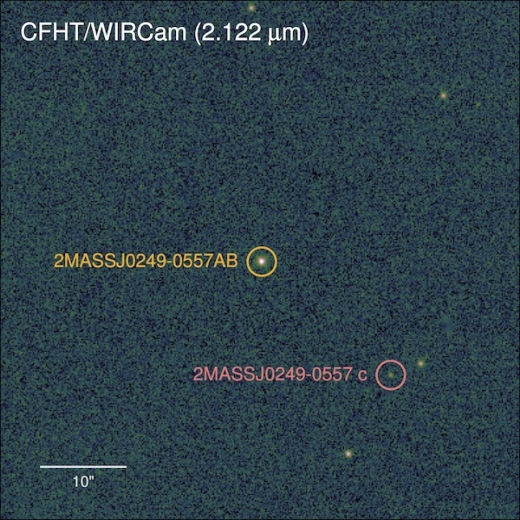
Image: Image of the 2MASS 0249 system taken with Canada-France-Hawaii Telescope’s infrared camera WIRCam. 2MASS 0249 c is located 2000 astronomical units from its host brown dwarfs, which are unresolved in this image. The area of sky covered by this image is approximately one thousandth the area of the full moon. Credits: T. Dupuy, M. Liu.
The difference in formation scenarios that Liu talks about is instructive. Here we have two host stars, one of them being a binary system of brown dwarfs, that formed in the same stellar nursery, as per their membership in the moving group. But while Beta Pictoris b, a gas giant of about 13 Jupiter masses, orbits a star 10 times brighter than the Sun, 2MASS 0249 c orbits a brown dwarf pair 2000 times fainter. At a distance of 9 AU, Beta Pictoris b is relatively close to its star, while 2MASS 0249 c is a whopping 2000 AU from its brown dwarf hosts.
These distances imply different formation scenarios. Beta Pictoris b likely formed from the accumulation of dust grains in the circumstellar disk surrounding its star. 2MASS 0249 c could not have done so, given that the two brown dwarfs it orbits would not have had sufficient disk material to produce it. That implies the new planet took form through the gravitational collapse of a gas cloud found in the original stellar birth cluster.
“2MASS 0249 c and beta Pictoris b show us that nature has more than one way to make very similar looking exoplanets,” says Kaitlin Kratter, astronomer at the University of Arizona and a collaborator on this work. “They’re both considered exoplanets, but 2MASS 0249 c illustrates that such a simple classification can obscure a complicated reality.”
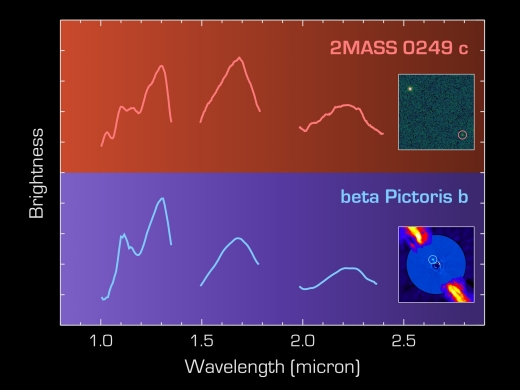
Image: The infrared spectra of 2MASS 0249 c (top) and beta Pictoris b (bottom) are similar, as expected for two objects of comparable mass that formed in the same stellar nursery. Unlike 2MASS 0249 c, beta Pictoris b orbits much closer to its massive host star and is embedded in a bright circumstellar disk. Credit: T. Dupuy, ESO/A.-M. Lagrange et al.
What we get out of all this is opportunity. The formation of gas giants is a key phase in the emergence of new planetary systems, and being able to use direct imaging to study such worlds means we can probe their atmospheres directly, examining the composition, surface temperature, chemistry and other physical properties of the exoplanet. Moreover, direct imaging is most effective when working with planets far from their star, as this object is. If we are after insights into gas giant formation, the different formation pathways for Beta Pictoris b and 2MASS 0249 c may provide evidence both orbital and spectral. The paper notes:
As directly imaged objects, ? Pic b and 2MASS J0249?0557 c provide a new opportunity to test atmospheric compositions and angular momentum evolution for a close-in planet and a very wide companion that share a common mass and age and that formed from the same material.
And on the issue of spectra:
If different formation mechanisms produced these objects, then their spectra could contain evidence of their divergent pasts. As noted above, we suspect that 2MASS J0249?0557 c arose from a star-formation-like process of global, top-down gravitational collapse in the same way as the freefloating object 2MASS J2208+2921. On the other hand, ? Pic b bears architectural resemblance to planetary systems and thus may have formed via core accretion. Core accretion models and observations of solar system gas giants show substantial metal enrichment (e.g., Stevenson 1982; Bolton et al. 2017). Thus, if ? Pic b is a scaled-up gas giant (?13 MJup), then we may expect to see substantial metal enrichment in its atmosphere.
What an interesting find 2MASS 0249c turns out to be. Is it a planet or actually a brown dwarf? One thing is for sure: The discovery puts a spotlight on the boundary between planet and brown dwarf, both in terms of composition and in terms of formation history. Maybe it’s best to fall back on how today’s paper describes the object: a ‘planetary-mass companion.’ Now we can go to work, via direct imaging, on issues like variability, rotation and atmospheric composition. How these data vary across different formation histories should occupy astronomers for some time.
The paper is Dupuy et al., “The Hawaii Infrared Parallax Program. III. 2MASS J0249-0557 c: A Wide Planetary-mass Companion to a Low-mass Binary in the beta Pic Moving Group,” accepted at the Astronomical Journal (preprint).

